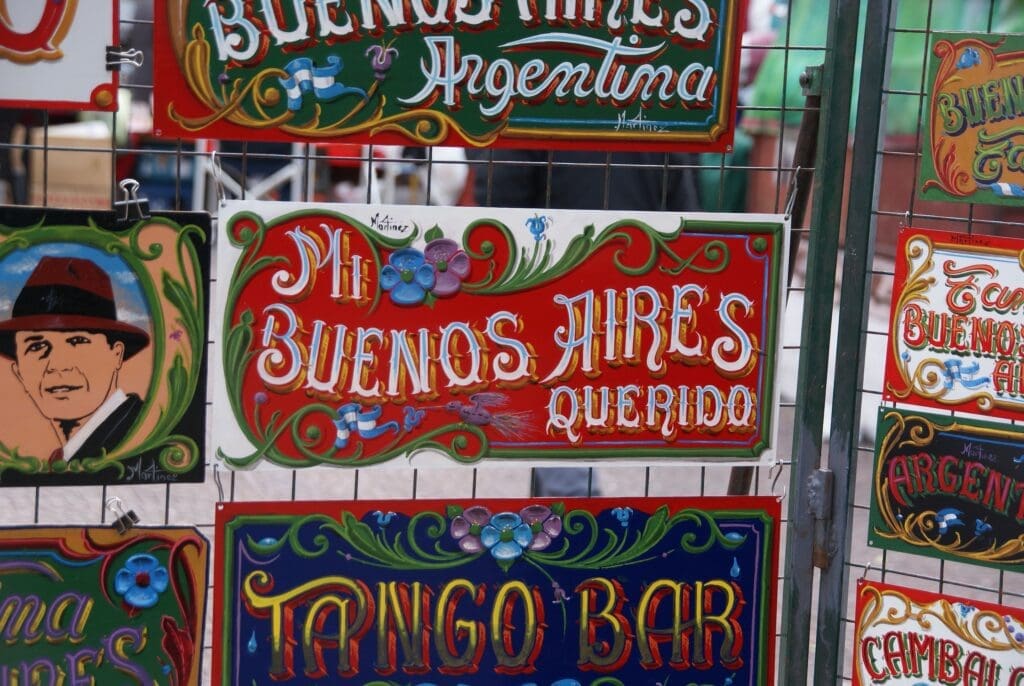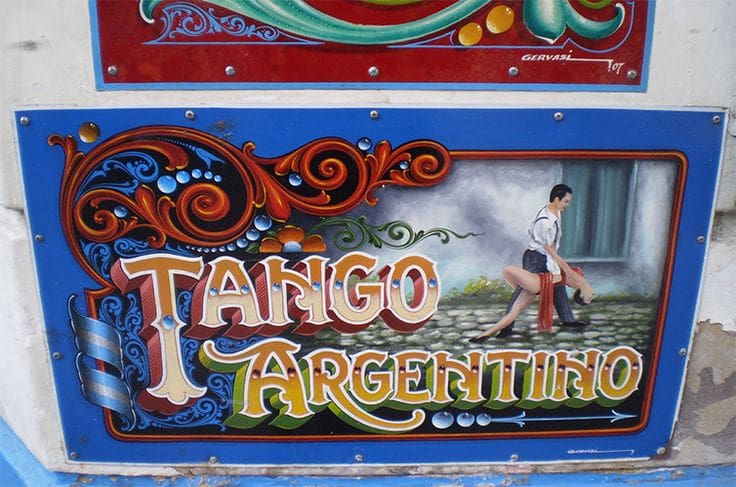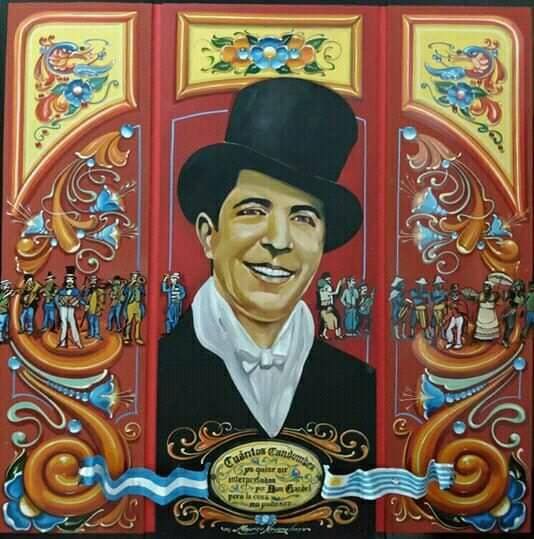As you explore the streets of Buenos Aires, you might notice a common decorative motif in shop windows, on buildings, or even on vehicles. These brightly colored, stylized designs are known as fileteado, which has become firmly established as the porteño style of art. The name fileteado comes from the Latin word for thread, filum, and originally referred to the long, fine lines that were key elements in the decoration.
In the early 19th century, when fileteado began, horse-drawn carts transporting various goods were among the first objects to be painted. Although the precise origins are difficult to trace, some of the earliest fileteadores were Vicente Brunetti, Cecilio Pascarella, and Salvador Venturo. These artists, among others, began decorating their carts in this fashion, which gradually evolved to incorporate flowers, dragons, birds, horseshoes, and other symbols. This decorative art spread from carts to other forms of transportation, such as buses, trucks, storefronts, and signs.
Some of the main characteristics of fileteado are its symmetry, bright colors, shading and highlighting to create depth, highly stylized designs, Gothic-style fonts, framing of the finished product, and the use of symbols (for example, horseshoes for good luck). This authentically porteño art style was officially declared Cultural Heritage of the City of Buenos Aires in April 2006.
If you’d like to learn more about fileteado as an art form, you can check out the book Tratado de Fileteado Porteño by Alfredo Genovese. Genovese, a renowned Argentine fileteador, has written several books on the topic, but this particular book covers every aspect, from themes, motifs, and design to the technical aspects and historical applications—from buses to body art. Best of all, it features plenty of full-color illustrations!
Today, you can easily find fileteado in San Telmo, at El Caminito in La Boca, and on Jean Juares in Abasto. If you want to bring some fileteado home with you, be sure to stop at the feria (market fair) on San Telmo’s Calle Defensa or at a shop in El Caminito, where you’ll find signs with all sorts of declarations for sale.


As you continue to explore the streets of Buenos Aires, you might find yourself captivated by the hand-painted signs that add a unique charm to storefronts and buildings. These signs, often crafted with the same attention to detail as fileteado, are the work of skilled sign painters who carry on a traditional craft that is deeply embedded in the city’s culture.
Much like the fileteado artists, these sign painters infuse their creations with vibrant colors, intricate designs, and a sense of local pride that makes Buenos Aires so visually distinct. Their work not only beautifies the city but also tells a story of craftsmanship passed down through generations.
Immerse yourself in the world of Buenos Aires sign painters and discover the artistry that breathes life into the city’s bustling streets. As you delve into this rich tradition, you’ll also uncover why Buenos Aires, with its deep cultural roots and artistic vibrancy, stands out as one of the best destinations to learn Spanish in Buenos Aires but also to Study Spanish in Malaga and Online. Get ready to explore the colorful and creative heart of Buenos Aires!
The Story of Signwriters of Bueno Aires: Fileteado
The signwriters of Buenos Aires are a dedicated group of artisans who are passionate about their craft. They have honed their skills over many years and have become experts in hand-painted signage. These talented individuals work with a variety of mediums, including paint, brushes, and stencils, to create unique and visually appealing signs. Each signwriter has their own style and techniques, which they have developed through years of practice and experience. They take pride in their work and strive to create signage that captures the essence of Buenos Aires.
One of the renowned signwriters in Buenos Aires is Diego Lopez, who specializes in custom hand-painted signs for local businesses. His meticulous brushwork and attention to detail have made him a sought-after sign maker in the city. Diego combines traditional lettering techniques with his own artistic flair, resulting in signage that is both visually stunning and highly effective. He believes that hand-painted signs add a personal touch to businesses, creating a connection with customers that digital signage cannot replicate.
Another prominent signwriter is Sofia Ramirez, known for her vibrant and playful mural designs. Sofia’s work can be found adorning the walls of cafes, restaurants, and art galleries throughout Buenos Aires. She incorporates elements of the city’s culture and history into her murals, telling stories through her art. Sofia’s ability to blend her artistic style with the client’s vision has made her a beloved figure in the Buenos Aires signage artist community.


The Signwriters’ Process
Creating hand-painted signs requires a meticulous process that begins with conceptualization and design. Signwriters collaborate closely with their clients to understand their brand identity, target audience, and desired message. Once the design is finalized, the signwriter carefully transfers it onto the sign surface, whether it’s a storefront, mural wall, or vintage signboard. They then proceed to meticulously paint each letter, illustration, or detail by hand, using various techniques to achieve the desired effect.
Unlike digital signage, hand-painted signs embody the human touch and craftsmanship that can instantly grab attention and establish a connection with passersby. The imperfections and nuances of hand-painted signage give it a unique character and authenticity that resonates with the local community.
Whether it’s a vintage-inspired sign adorning a local boutique or a vibrant mural that brightens up a street corner, the work of Buenos Aires signwriters enriches the visual landscape of the city. Their dedication to preserving the art of hand-painted signage ensures that the craft continues to thrive and flourish in Buenos Aires.
Traditional Sign Painting Techniques
Traditional sign painting techniques are at the core of creating hand-painted signs in Buenos Aires. These techniques ensure the unique and captivating nature of each signage, capturing the essence of the city’s vibrant streets. Signwriters in Buenos Aires employ a range of time-honored methods to achieve the desired visual impact and convey the intended message effectively.
One of the key techniques employed by signwriters is hand lettering. They painstakingly paint each letter by hand, paying close attention to detail and ensuring precision. This process allows for artistic expression and customization, making each sign a one-of-a-kind masterpiece.
Brushwork is another vital technique used in traditional sign painting. Signwriters skillfully use various brushes to achieve different strokes and textures, adding depth and dimension to their artwork. The brushwork technique emphasizes the craftsmanship and artistry evident in hand-painted signs, setting them apart from digitally printed signage.
The use of vibrant colors is an essential aspect of traditional sign painting. Signwriters carefully select and mix colors to bring life and visual impact to their signs. The vibrant hues not only catch the eye but also evoke emotions, effectively communicating the intended message to passersby.
To ensure precision and ensure the desired outcome, signwriters begin by sketching out their design on the sign surface. This preliminary step allows them to plan the layout and ensure the proper placement of each element. With the design in place, the signwriters then embark on the intricate process of meticulously hand painting each letter and detail.
Traditional sign painting techniques in Buenos Aires result in visually captivating and authentic signage that stands out in a sea of mass-produced commercial signs. The dedication and mastery of signwriters breathe life into the city’s streets, making each sign a work of art.


The Artistry of Hand-Painted Signs
The artistry of hand-painted signs in Buenos Aires is truly exceptional. Signwriters in this vibrant city pay meticulous attention to detail, ensuring that each sign is a masterpiece of typography, layout, and design. By incorporating vibrant colors and decorative elements, these artisans create visually stunning signage that captivates attention and conveys messages with flair.
Unlike mass-produced commercial signage, hand-painted signs bring a unique charm and authenticity to the streets of Buenos Aires. Each sign is a reflection of the signwriter’s creativity and craftsmanship, standing out as a testament to their artistic skill. The intricate details and vibrant colors on these signs add a touch of elegance to the already vibrant cityscape, turning the streets into an open-air gallery of artistic expression.
Attention to Detail
One of the key characteristics of hand-painted signs in Buenos Aires is the remarkable attention to detail. Signwriters painstakingly hand-paint each letter and decorative element, ensuring the utmost precision and artistry. This dedication to detail allows them to create signage that is not only visually appealing but also communicates messages effectively. Whether it’s a storefront sign, a restaurant menu, or a mural, the artistry of hand-painted signs captures the essence and personality of the businesses they represent.
Expressive Typography
Typography is a vital element in hand-painted signs, and Buenos Aires signwriters excel in this aspect. They skillfully combine different lettering styles and sizes to create harmonious and eye-catching designs. The expressive typography adds character and personality to the signs, making them truly stand out. Each signwriter has their own unique approach to typography, showcasing their personal style and artistic flair.
Custom Designs and Flourishes
In addition to typography, Buenos Aires signwriters often incorporate custom designs and flourishes into their hand-painted signs. These decorative elements elevate the aesthetic value of the signage, adding a touch of elegance and uniqueness. From intricate borders and filigree to whimsical illustrations and motifs, these custom designs make each hand-painted sign a work of art.
By infusing their creative ideas into every brushstroke, Buenos Aires signwriters transform simple signs into visually stunning pieces that enhance the city’s visual landscape. These unique hand-painted signs not only draw attention but also create a connection between businesses and the community they serve.
The Importance of Hand-Painted Signs in Buenos Aires
Hand-painted signs play a crucial role in the vibrant streets of Buenos Aires, serving as a form of public art and a reflection of the city’s unique culture and identity. These signs add character and charm to the bustling streets, contributing to the city’s overall visual appeal.
Unlike mass-produced commercial signage, hand-painted signs in Buenos Aires are custom-made and tailored to represent businesses and establishments in a distinctive way. Many local businesses opt for hand-painted signs to showcase their brand and stand out from the competition. These signs not only fulfill a functional purpose but also enhance the aesthetic experience of the city’s streets.
The significance of hand-painted signs is rooted in their ability to capture the essence of Buenos Aires, celebrating the city’s artistic spirit. These signs are often intricately designed and thoughtfully crafted by skilled signwriters who possess a deep understanding of typography, layout, and design principles. The attention to detail and craftsmanship present in each hand-painted sign is a testament to the immense pride and passion of Buenos Aires sign painters.
As visitors and locals stroll through the streets of Buenos Aires, hand-painted signs serve as visual markers of the city’s identity and provide a unique cultural experience. Whether it’s the vibrant colors, distinctive lettering, or artistic flourishes, these signs evoke a sense of authenticity and add a touch of nostalgia to the urban landscape.


Hand-Painted Signs: Adding Character to Buenos Aires
From the historic neighborhoods of San Telmo and La Boca to the trendy district of Palermo, hand-painted signs create a distinctive atmosphere that embodies the spirit of Buenos Aires. These signs have the power to transform ordinary storefronts into works of art, capturing the attention of passersby and creating a lasting impression.
The enduring popularity of hand-painted signs in Buenos Aires is a testament to their profound impact on the city’s visual landscape. In an age of digital advertising, these signs remain a cherished part of Buenos Aires’ cultural heritage, preserving a traditional craft that continues to captivate locals and visitors alike.
Signwriters’ Stories: Preserving a Traditional Craft
Signwriting in Buenos Aires is not just a job, it’s a passion that runs deep in the veins of the city’s skilled artisans. Each signwriter has a unique story, shaped by their background in the arts and their unwavering dedication to preserving the tradition of hand-painted signs. These talented individuals see themselves as more than just painters; they are keepers of a craft that has been passed down through generations.
“I come from a family of artists, and signwriting has always been in my blood,” says Santiago Torres, a renowned Buenos Aires signage artist. “I feel a deep connection to the history and tradition of hand-painted signs, and it’s my mission to keep this art form alive.”
For Santiago and his fellow signwriters, traditional sign painting goes beyond just creating visually appealing signage. It’s about capturing the soul of Buenos Aires and preserving the city’s cultural identity. These artists take pride in the fact that every stroke of their brush adds a touch of beauty and character to the streets.
Meet Lucía Morales, another Buenos Aires sign painter who has been honing her craft for over two decades. She believes that hand-painted signs have a unique charm that cannot be replicated by modern technology.
“There’s a certain warmth and authenticity in hand-painted signs that you just can’t achieve with digital printing,” says Lucía. “Each sign is a work of art, crafted with love and attention to detail.”
Lucía’s sentiment is shared by many other signwriters in Buenos Aires. They understand the value of preserving traditional sign painting techniques in a world dominated by digital advertisements and mass-produced signage. By keeping the art of hand-painted signs alive, these artists ensure that the streets of Buenos Aires continue to tell stories and evoke emotions.
Although the digital age has brought about new challenges, the signwriters of Buenos Aires remain resilient, finding innovative ways to blend modern technology with traditional craftsmanship. They embrace the use of digital design tools and imaging software, while still emphasizing the meticulous process of hand-painting each sign.
The artisanal approach of Buenos Aires sign painters is what sets them apart. They pay close attention to typography, color palette, and composition, ensuring that every sign they create is a unique masterpiece tailored to the client’s vision. Their dedication is reflected in the quality and artistry of their work.
Preserving a traditional craft is not always easy, but the signwriters of Buenos Aires are driven by their passion for the art of hand-painted signs. They strive to keep the spirit of Buenos Aires alive through their work, adding beauty and character to the city’s streets one sign at a time.
The Future of Hand-Painted Signs in Buenos Aires
While the digital age has brought about advancements in signage technology, hand-painted signs continue to hold a special place in Buenos Aires. The demand for custom hand-painted signs remains strong as businesses and individuals appreciate the unique and personalized nature of these signs. Signwriters are adapting to the changing landscape by incorporating digital tools into their workflow while still embracing traditional techniques. The future of hand-painted signs in Buenos Aires looks promising, with signwriters continuing to showcase their creativity and craftsmanship.
Digital Tools and Traditional Techniques
Incorporating digital tools into their workflow allows signwriters in Buenos Aires to streamline the design process and enhance their creations. Design software and digital tablets offer increased precision and flexibility in sketching out designs before transferring them onto the sign surface. However, despite the convenience of digital tools, Buenos Aires sign makers remain committed to preserving traditional techniques. They believe in the authenticity and charm that can only be achieved through the hand-painted process.
The Personalized Touch of Hand-Painted Signs
One of the main reasons why hand-painted signs continue to be in demand is the ability to add a personalized touch. Each sign is a unique work of art, crafted by skilled signwriters who pour their creativity and expertise into every stroke of the brush. Custom hand-painted signs allow businesses and individuals to stand out from the crowd and communicate their message in a visually captivating way. This personalization creates a connection with the audience and adds a sense of authenticity that cannot be replicated by mass-produced signage.
Preserving Artistry and Craftsmanship
Hand-painted signs in Buenos Aires are more than just a form of advertising; they are a testament to the artistry and craftsmanship of signwriters. These talented individuals take immense pride in their work and strive to create pieces that are not only visually appealing but also tell a story. By preserving this traditional craft, signwriters are ensuring that future generations can continue to appreciate the beauty and character of hand-painted signs. This commitment to preserving artistry and craftsmanship ensures that hand-painted signs will remain a part of Buenos Aires’ visual landscape for years to come.
Digital Tools vs. Traditional Techniques
| Digital Tools | Traditional Techniques |
|---|---|
| Enhanced precision in design | Authenticity and charm |
| Streamlined workflow | Craftsmanship and attention to detail |
| Flexibility in editing and revisions | Unique and personalized touch |


Despite advancements in digital tools, Buenos Aires sign makers remain committed to preserving traditional hand-painted sign techniques, ensuring that each sign is a unique work of art that captures the essence of the city’s vibrant streets.
Exploring Buenos Aires’ Hand-Painted Signage Scene
Visitors to Buenos Aires have the opportunity to immerse themselves in the vibrant hand-painted signage scene that adorns the city’s streets. With its rich artistic heritage and thriving culture, Buenos Aires showcases the creativity and talent of local signwriters through their unique and captivating hand-painted signs. In particular, neighborhoods like San Telmo, Palermo, and La Boca are known for their abundance of artisan signs that reflect the spirit of Buenos Aires.
When exploring these neighborhoods, one can’t help but be drawn to the intricate details and distinctive designs of the hand-painted signs that line the streets. Each sign tells a story and showcases the craftsmanship of the signwriters who put their heart and soul into their work. From the elegant brush strokes to the skillful use of colors, these hand-painted signs captivate the attention and imagination of passersby.
Walking through the streets of Buenos Aires, visitors will encounter a burst of creativity and artistic expression at every turn. Whether it’s a charming sign for a local café, an eye-catching mural on a building facade, or a beautifully hand-painted storefront, the signwriters of Buenos Aires leave their mark on the city’s visual landscape.
This immersive experience allows individuals to appreciate the artistry and dedication of Buenos Aires’ signwriters firsthand. It is an invitation to observe the meticulous craftsmanship and attention to detail that goes into every stroke of the brush. By exploring the hand-painted signage scene, visitors can gain a deeper understanding of the cultural significance and the enduring appeal of artisan signs in Buenos Aires.


Maria Olson
At VAMOS Academy, I craft stories sprinkled with my love for exploration and food. Whether it’s the tang of a local dish or the rhythm of a new dialect, I bring these experiences to you. Ready for an adventure that tickles your taste buds and ignites your wanderlust? Let’s embark on this journey together, one story and one bite at a time.







